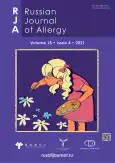Plant pollination calendar of the Southern Coast of Crimea and elimination therapy at the resort
- Authors: Belyaeva S.N.1, Pirogova M.E.2, Govorun M.I.1
-
Affiliations:
- Academic scientific-research Institute of physical treatment methods, medical climatology and rehabilitation named after I.M. Sechenov
- Simferopol Polyclinic No 4”
- Issue: Vol 18, No 4 (2021)
- Pages: 18-28
- Section: Original studies
- URL: https://journals.rcsi.science/raj/article/view/121608
- DOI: https://doi.org/10.36691/RJA1461
- ID: 121608
Cite item
Abstract
BACKGROUND: Plant pollen can influence the climatotherapy and elimination therapy results of respiratory allergic diseases. Flora diversity and the poorly studied prevalence and etiology of pollinosis on the Southern Coast of Crimea determine the need for aeropalinological studies of this region to optimize the treatment and rehabilitation of patients with respiratory sensitization.
AIMS: To determine the potentially unfavorable periods for the stay of patients with pollen sensitization on the Southern Coast of the Crimea and develop a plant pollination calendar of the Yalta resort
MATERIALS AND METHODS: The research was conducted in the coastal and foothill area of Yalta in 2011–2013. The study determined the content of pollen in plants that are passively deposited from the air onto the glasses-traps using the gravimetric method. The taxonomic belonging of the pollen was established by collecting the plant pollen of the Southern Coast of Crimea.
RESULTS: A total of 19 pollen taxa have been identified in the air of Yalta, of which 10 had sensitizing properties. Cypress (49.7% of pollen of the average annual amount) and most deciduous trees with allergenic pollen (4.7% of pollen) were intensively pollinated in March–April, Poaceae grasses (1.6% of pollen) in May, and weed grasses (1.6% of pollen) in late August to early September. Birch and alder pollen was not detected. On average, 2.2 times less pollen was detected in the coastal area air of the resort than in the foothill area. The plant pollination calendar of the Yalta resort has been developed.
CONCLUSIONS: The intensive cypress pollination period in March–April is least favorable for patients with pollen sensitization to stay on the Southern Coast of the Crimea. Poaceae in May and weeds in late August to early September create an insignificant pollen load. A plant pollination calendar has been developed to predict unfavorable aeropalinological periods and optimize the treatment and rehabilitation of patients with pollen sensitization in the Yalta resort. The best conditions for the treatment and rehabilitation of patients with respiratory allergies have been identified in the coastal area of the resort. The absence of birch and alder pollen in the air contributes to the elimination therapy at the Yalta resort.
Full Text
##article.viewOnOriginalSite##About the authors
Svetlana N. Belyaeva
Academic scientific-research Institute of physical treatment methods, medical climatology and rehabilitation named after I.M. Sechenov
Author for correspondence.
Email: belyaeva-1956@yandex.ru
ORCID iD: 0000-0002-6161-6058
SPIN-code: 1439-6960
Scopus Author ID: 816988
MD, Cand. Sci. (Med.)
Russian Federation, 10/3 Mukhina Str., Yalta, 298603, Republic of CrimeaMaria E. Pirogova
Simferopol Polyclinic No 4”
Email: pirogovamariya@inbox.ru
ORCID iD: 0000-0002-5801-0282
SPIN-code: 6312-9588
MD, Cand. Sci. (Med.)
Russian Federation, SimferopolMaria I. Govorun
Academic scientific-research Institute of physical treatment methods, medical climatology and rehabilitation named after I.M. Sechenov
Email: masha.jalta@mail.ru
ORCID iD: 0000-0002-6278-2322
SPIN-code: 8986-2695
Cand. Sci. (Biol.)
Russian Federation, 10/3 Mukhina Str., Yalta, 298603, Republic of CrimeaReferences
- Shamgunova BA, Levitan BN, Sartova AR, et al. Properties of pollen allergens and their clinical significance. Russian Journal of Allergy. 2014;(5):21–27. (In Russ).
- Belyaeva SN, Govorun MI, Pirogova ME. Pollen map and pollinoses of some European countries, Turkey and the Southern coast of Crimea in a comparative aspect (review). In: Topical issues of balneology, physiotherapy and medical rehabilitation: proceedings of the State Medical Institution of the Republic of Kazakhstan “Academic Research Institute of Physical Methods of Treatment, Medical Climatology and Rehabilitation named after I.M. Sechenov”. Vol. XXV. Materials of the scientific and practical conference with international participation dedicated to the 100th anniversary of the founding of the Romanov Institute of Physical Methods of Treatment; October 9–10, 2014. Yalta; 2014. Р. 111–116. (In Russ).
- Sergin SYa, Tsai SN, Magulyan AO. Features of the subtropical climate of the northern coastal zone of the Mediterranean. In: Modern problems of hydrometeorology and sustainable development of the Russian Federation: collection of abstracts of the All-Russian Scientific and Practical Conference; March 14–15, 2019. Saint Petersburg; 2019. Р. 152–153. (In Russ).
- Savchenko VM. Climatotherapy for respiratory diseases in the Crimean resorts: history and current status. Resort Medicine. 2016;(1):105–113. (In Russ).
- Golovko VV. Environmental aspects of aeropalinology: analytical review. (Ecology series). Vol. 73. Novosibirsk; 2004. 106 p. (In Russ).
- Vovk AG, Kalinichenko MG, Kozhevnikova SK, et al. Determinant of higher plants of the Crimea. Ed. by N.I. Rubtsov. Leningrad: Nauka; 1972. 550 p. (In Russ).
- Minaeva NV, Novoselova LV, Рlokhina KV, Shiryaeva DM. Pollen sensitization and aeropalinological monitoring in determining significant allergens in early spring pollinosis. Russian Journal of Allergy. 2015;(2):19–24. (In Russ).
- Nilsson S, Spieksma FTh, eds. Allergy service giede in Europe. Stockholm; 1994. 123 p.
- Durham C. The volumetric incidence of atmospheric allergens: A proposed standard method of gravity sampling, counting, and volumetric interpolation of results. Journal of Allergy. 1946;17(2):79–86. doi: 10.1016/0021-8707(46)90025-1
- Posevina YuM. Palinoecological monitoring of the atmospheric air of the city of Ryazan [dissertation abstract]. Moscow; 2011. 24 p. Available from: https://search.rsl.ru/ru/record/01004849995. Accessed: 05/18/2021. (In Russ).
- Shamgunova BA, Zaklyakova LV. Epidemiology of pollinosis: facts, main tendencies. Astrakhan Medical Journal. 2010;5:(2):10–18. (In Russ).
- Macharadze DSh. Some features of the prevalence of respiratory allergy in Southern Russia. Russian Journal of Allergy. 2019;16(1):23–28. (In Russ).
- Khabibulina LR, Vlasova NV, Manzhos MV, et al. Palinological spectrum in Samara and its influence on the course of pollinosis. Russian Journal of Allergy. 2015;(3):3–7. (In Russ).
- Zhuykova IA, Pupysheva SA, Zhuykova ZG. Pollen rain` aeropalinological studies of Russian Plain` North-East. Theoretical and Applied Ecology. 2015;(2):25–33. (In Russ).
- Nenasheva GI. Aeropalinological monitoring of allergenic plants of Barnaul. Ed. by A.Sh. Khabidov. Novosibirsk; 2013. 130 p. (In Russ).
Supplementary files
















